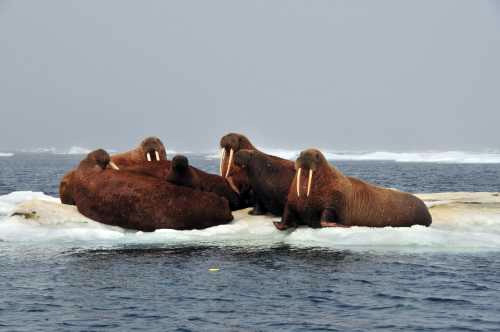
Pacific Walruses Studied as Sea Ice Melts
August 17, 2011
Walruses spend most of their lives at sea, but haul out on sea ice and sometimes land to rest between feeding bouts. They can dive hundreds of feet to forage on the sea floor. However, when the sea ice recedes past the continental shelf into very deep waters of the Arctic Basin, the walruses haul out on land. The extent of sea ice has been less in recent summers, and walruses have been hauling out on beaches in Alaska and Russia in the past few years. Thus, radio-tracking the walruses’ movements in water and to and from land provides important insights into walrus movements and foraging behaviors in response to changing sea ice conditions. Walruses resting on an ice floe in the Chukchi sea.
“Sea ice is an important component in the life cycle of walruses,” said Chad Jay, research ecologist with the USGS Alaska Science Center. “These tracking studies will help us to better understand how top consumers in the arctic ecosystem may be affected by changes in sea ice habitats.” In July, the scientists attached 40 radio tags on walruses hauled out on distant offshore sea ice near the edge of the continental shelf, northwest of Barrow, Alaska. This month researchers will tag a number of walruses that have come to land after the retreat of the sea ice from the shelf. Tracking animations from tagged walruses are available online and are updated approximately every week. For photos and more information related to the USGS Pacific walrus studies visit http://www.usgs.gov/blogs/features/
On the Web:
Source of News:
E-mail your news &
photos to editor@sitnews.us
|
||
